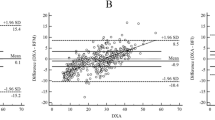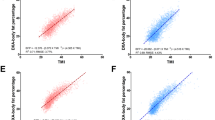Abstract
Background
The pediatric relative fat mass (RFM) has been recently presented and validated as an index for estimating percentage body fat (%BF) in North American children and adolescents. Similar to body mass index (BMI) and tri-ponderal mass index (TMI), RFM uses anthropometric measures (i.e., weight, height and waist circumference) to estimate body composition. The primary purpose of this study was to validate the newly developed RFM equation for %BF prediction in Southern Brazilian adolescents; as secondary objective, we compared %BF estimation from BMI- and TMI-derived equations.
Methods
A total of 631 individuals (434 boys) aged 11 to 18 were analyzed. Bland–Altman analyses were used to determine concordance between predicted equations and %BF measured by DXA; results are presented using mean difference (i.e., bias) and standard deviation. Sensitivity and specificity were calculated for %BF percentile classifications.
Results
RFM underestimated %BF in 65.2% of boys (− 4.3 ± 2.8%) and 84.8% of girls (− 5.3 ± 2.7%). In contrast, TMI overestimated %BF in 62.9% of boys (4.0 ± 2.9%) and 56.3% (3.5 ± 3.0%) of girls. The performance of BMI showed mixed results; %BF was overestimated in 68.4% of boys (5.0 ± 4.0%) and underestimated in 67.5% of girls (− 3.9 ± 2.6%), all p < 0.001. Although, RFM had the highest specificity for %BF percentile classifications, sensitivity was low and inferior to BMI and TMI.
Conclusion
TMI was superior to RFM and BMI in predicting %BF in Southern Brazilian adolescents. Using RFM, BMI or TMI equations for %BF prediction without a population-specific correction factor may lead to incorrect interpretations. We suggest that correction factors should be investigated to improve the accuracy of these surrogate indices for body composition assessment.
Level of evidence
Level V, cross sectional descriptive study.




Similar content being viewed by others
Data availability
All relevant data are within the manuscript and its Supporting Information files.
References
Bentham J, Di Cesare M, Bilano V, Bixby H, Zhou B, Stevens GA et al (2017) Worldwide trends in body-mass index, underweight, overweight, and obesity from 1975 to 2016: a pooled analysis of 2416 population-based measurement studies in 128·9 million children, adolescents, and adults. Lancet 390:2627–2642. https://doi.org/10.1016/S0140-6736(17)32129-3
Sharma V, Coleman S, Nixon J, Sharples L, Hamilton-Shield J, Rutter H et al (2019) A systematic review and meta-analysis estimating the population prevalence of comorbidities in children and adolescents aged 5 to 18 years. Obes Rev 20:1341–1349. https://doi.org/10.1111/obr.12904
Freedman DS, Khan LK, Serdula MK, Dietz WH, Srinivasan SR, Berenson GS (2005) The relation of childhood BMI to adult adiposity: the Bogalusa heart study. Pediatrics 115:22–27. https://doi.org/10.1542/peds.2004-0220
Vanderwall C, Randall Clark R, Eickhoff J, Carrel AL (2017) BMI is a poor predictor of adiposity in young overweight and obese children. BMC Pediatr 17:4–9. https://doi.org/10.1186/s12887-017-0891-z
Peterson CM, Su H, Thomas DM, Heo M, Golnabi AH, Pietrobelli A et al (2017) Tri-ponderal mass index vs body mass index in estimating body fat during adolescence. JAMA Pediatr 171:629–636. https://doi.org/10.1001/jamapediatrics.2017.0460
Woolcott OO, Bergman RN (2018) Relative fat mass (RFM) as a new estimator of whole-body fat percentage—a cross-sectional study in American adult individuals. Sci Rep 8:1–11. https://doi.org/10.1038/s41598-018-29362-1
Woolcott OO, Bergman RN (2019) Relative fat mass as an estimator of whole-body fat percentage among children and adolescents: a cross-sectional study using NHANES. Sci Rep. https://doi.org/10.1038/s41598-019-51701-z
Paek JK, Kim J, Kim K, Yeong LS (2019) Usefulness of relative fat mass in estimating body adiposity in Korean adult population. Endocr J 66:723–729. https://doi.org/10.1507/endocrj.ej19-0064
Ulbricht L, De Campos MF, Esmanhoto E, Ripka WL (2018) Prevalence of excessive body fat among adolescents of a south Brazilian metropolitan region and State capital, associated risk factors, and consequences. BMC Public Health 18:1–11. https://doi.org/10.1186/s12889-018-5216-0
Ogden CL, Carroll MD, Lawman HG, Fryar CD, Kruszon-Moran D, Kit BK, Flegal KM (2016) Trends in obesity prevalence among children and adolescents in the United States, 1988–1994 through 2013–2014. JAMA 315:2292–2299. https://doi.org/10.1016/j.physbeh.2017.03.040
Field A (2009) Descobrindo a estatística utilizando o SPSS, 1st edn. Artmed, Porto Alegre
Nascimento VG, Bertoli CJ, Gallo PR, de Abreu LC, Leone C (2019) Tri-ponderal mass index: a screening tool for risk of central fat accumulation in brazilian preschool children. Medicina (B Aires) 55:577. https://doi.org/10.3390/medicina55090577
Neves FS, de Oliveira Alvim R, Zaniqueli D, Pani VO, Martins CR, de Souza Peçanha MA et al (2020) Tri-ponderal mass index is useful for screening children and adolescents with insulin resistance. Rev Paul Pediatr 38:e2019066. https://doi.org/10.1590/1984-0462/2020/38/2019066
Ogden CL, Li Y, Freedman DS, Borrud LG, Fleegan KM (2011) Smoothed percentage body fat percentiles for U.S. children and adolescents, 1999–2004. Natl Health Stat Report 43:1–7
Liu J, Yan Y, Xi B, Huang G, Mi J (2019) Skeletal muscle reference for Chinese children and adolescents. J Cachexia Sarcopenia Muscle 10:155–164. https://doi.org/10.1002/jcsm.12361
Jeddi M, Dabbaghmanesh MH, Ranjbar Omrani G, Ayatollahi SMT, Bagheri Z, Bakhshayeshkaram M (2015) Relative importance of lean and fat mass on bone mineral density in iranian children and adolescents. Int J Endocrinol Metab. https://doi.org/10.5812/ijem.25542v2
Silva D, Ribeiro A, Pavão F (2013) Validity of the methods to assess body fat in children and adolescents using multi-compartment models as the reference method: a systematic review. Rev Assoc Med Bras 59:475–486. https://doi.org/10.1016/j.ramb.2013.03.006
Prado CMM, Heymsfield SB (2014) Lean tissue imaging: a new era for nutritional assessment and intervention. J Parenter Enter Nutr 38:940–953. https://doi.org/10.1177/0148607114550189
Funding
WLR and LU received funding from Programa de Pesquisa para o Sistema Único de Saúde: Gestão Compartilhada em Saúde PPSUS—edition 04/2012, Project number: 41614—FA, agreement 982/2013 with Universidade Tecnológica Federal do Paraná. CEO is supported by the Alberta Diabetes Institute and a recipient of the 2018 Alberta SPOR Graduate Studentship in Patient-Oriented Research, which is jointly funded by Alberta Innovates and the Canadian Institutes of Health Research. NL is researcher of Conselho Nacional de Desenvolvimento Científico e Tecnológico (CNPq). The funding body had no role in the design, collection, analysis, and interpretation of data; the writing of the manuscript; or the decision to submit the manuscript for publication.
Author information
Authors and Affiliations
Contributions
WLR contributed in designing, writing, and statistical analysis of this study. CO was responsible for data interpretation and writing. LU contributed with statistical analysis and conducting the study. AMQ, CMP, NL are responsible to data interpretation and manuscript revision. All authors approved the final manuscript.
Corresponding author
Ethics declarations
Conflict of interest
The authors declare that there is no conflict of interest.
Ethical approval
The study protocol has been approved by the ethics committee of the Universidade Tecnológica Federal do Paraná (Plataforma Brasil system, nº11583113.7.0000.5547).
Informed consent
All of the participants signed and approved a written informed consent before participation in the study.
Additional information
Publisher's Note
Springer Nature remains neutral with regard to jurisdictional claims in published maps and institutional affiliations.
Electronic supplementary material
Below is the link to the electronic supplementary material.
Rights and permissions
About this article
Cite this article
Ripka, W.L., Orsso, C.E., Haqq, A.M. et al. Validity and accuracy of body fat prediction equations using anthropometrics measurements in adolescents. Eat Weight Disord 26, 879–886 (2021). https://doi.org/10.1007/s40519-020-00918-3
Received:
Accepted:
Published:
Issue Date:
DOI: https://doi.org/10.1007/s40519-020-00918-3




